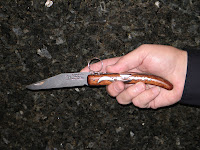

Harpercollins, 2004. ISBN 0-06-076340-X. 131 pages.
I suppose one could say that there are spoilers ahead but nothing that should diminish reading enjoyment. This is the second time I've read this book and, if anything, I enjoyed it more this time.
It is 1944 and an old beekeeper stops a young boy from an act that might have been fatal. The boy, who cannot or will not talk, is accompanied by an African gray parrot. The old man is surprised when the parrot begins reciting a strings of numbers in German. The old man speaks German to the boy and determines that is his native language. The boy and his parrot walk away without satisfying the old man's curiosity.
We then learn that the boy lives in a boarding house run by Mrs. Panicker, an Anglo married to a high church Anglican vicar who is "a Malayalee from Kerala, black as a bootheel." The other residents include their son, Reggie, a larcenous layabout, Mr. shane, a traveling salesman, and Mr. Parkins, a researcher in architectural history. We get the impression that there might be more to Shane and Parkins than is apparent.
The old man is sitting outside his front door when Inspector Bellows and Detective Quint arrive to consult with the old man. Bellows has a problem and admits to the old man that "I'm new on the job, down here learning the ropes, as they say, and don't at all overrate my capabilities." The old man knew Bellows' grandfather who was also a policeman. "I have know a great many policeman" the old man says to Bellows and Quint.
A murder has occurred at the boarding house. Shane has been murdered by a savage blow from behind and Reggie has been arrested. The old man is not at all interested in getting involved until Bellows tells him that the parrot, Bruno, is missing. The old man finally agrees to look into the matter but only to find the parrot.
I was thinking about pastiches and homages to Sherlock Holmes when I remembered this little book and how much I enjoyed it. One feature that makes the book fun is that the name Sherlock Holmes never appears. Instead, we get clues from page one showing us that the 89 year old man is The Great Detective.
- When we meet him he is reading The British Bee Journal.
- We are told that "he had once made his fortune and his reputation through a long and brilliant series of extrapolations from unlikely groupings of facts."
- He has a great beak of a nose.
- He retired in 1914.
- He has "a battered coal scuttle in which he had once kept his pipes."
- His magnifying glass was a gift from the "sole great friend of his life."
Chabon wonderfully captures Holmes as an old man, toward the end of his life. It is both sad and affirming. Holmes' great intellect and deductive skills are diminished but what remains is enough to see the case through to a satisfying end.
Chabon's writing captures a nostalgia for Holmes in his prime and is quite evocative. I had to wipe my eyes several times as I read. Here is a passage from a page chosen at random:
Long life wore away everything that was not essential. Some old men finished their lives as little more than the sum total of their memories, others as nothing but a pair of grasping pincers, or a set of bitter axioms proved. It would please him well enough to amount to no more in the end than a single great organ of detection, reaching into the blackness for a clue.
This is an excellent story that Holmesians should enjoy. Highly recommended.







